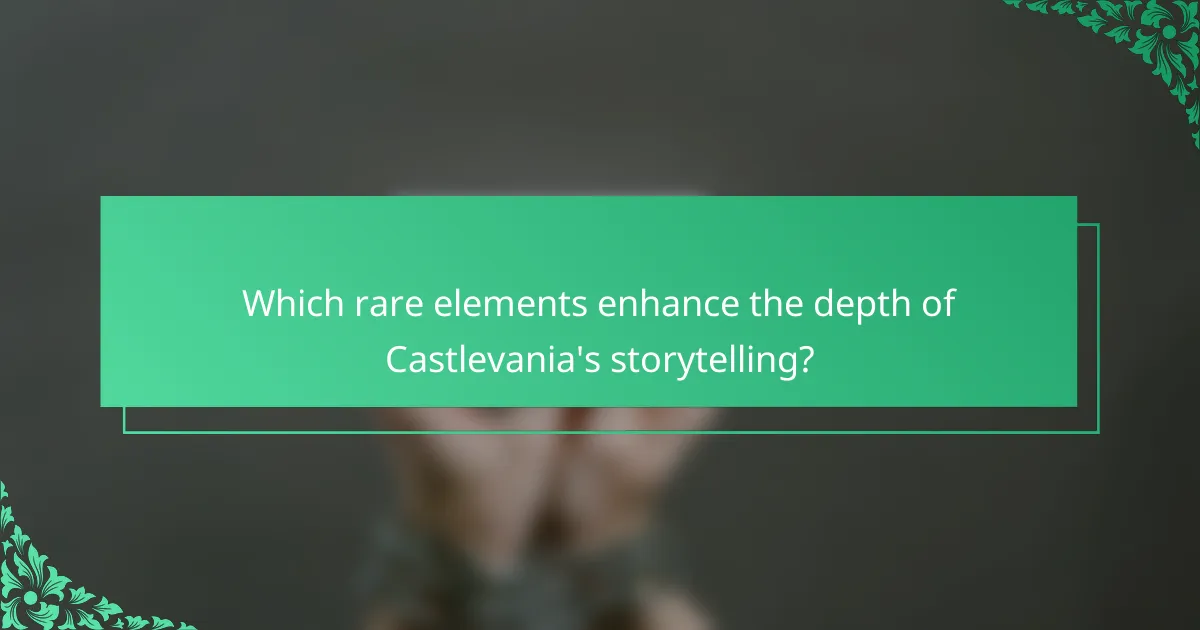Castlevania captivates players with its unique blend of exploration, combat, and atmospheric horror. The gameplay style emphasizes precise controls and challenging enemies, while the iconic music composition enhances immersion. Rich horror themes are woven throughout the narrative, featuring gothic visuals and complex character backstories. This article explores these key elements that define Castlevania’s enduring appeal.

How does Castlevania define its gameplay style?
Castlevania defines its gameplay style through a blend of exploration, combat, and platforming mechanics. The series emphasizes precise controls and challenging enemies, creating a rewarding experience. Unique attributes include the use of varied weapons and abilities, which enhance combat strategies. The atmospheric music composition complements the horror themes, deepening player immersion. Overall, Castlevania’s gameplay style is a hallmark of action-adventure design, influencing numerous titles in the genre.
What are the core mechanics that shape player experience?
The core mechanics that shape player experience in Castlevania include exploration, combat, music, and atmosphere. Exploration encourages players to navigate intricate levels filled with secrets. Combat mechanics emphasize skillful timing and strategy, enhancing engagement. The music composition creates an emotional backdrop, deepening the horror themes. Together, these elements foster a compelling and immersive experience.
Which character classes and abilities enhance gameplay diversity?
Character classes and abilities in Castlevania enhance gameplay diversity by offering unique playstyles and strategic options. Each class, such as the fighter or mage, brings distinct strengths, like melee combat proficiency or spellcasting versatility. Abilities, like double jump or elemental attacks, further diversify gameplay by enabling varied approaches to challenges. This variety encourages players to experiment and adapt, enriching the overall experience.
How do level design and exploration contribute to immersion?
Level design and exploration significantly enhance immersion in “Castlevania” by creating a cohesive atmospheric experience. The intricate layouts encourage players to navigate and discover hidden paths, fostering a sense of engagement.
The game’s gothic environments contribute to horror themes, with each level meticulously crafted to evoke tension. Exploration reveals lore and secrets, deepening the narrative connection. Unique attributes, like the use of music composition, further amplify emotional responses, making each encounter memorable.
As a result, players feel a stronger attachment to the game world, enhancing overall enjoyment and immersion.

What role does music composition play in the Castlevania series?
Music composition plays a crucial role in the Castlevania series by enhancing the atmosphere and emotional depth of the gameplay. The series is known for its iconic soundtracks that blend orchestral elements with gothic themes, creating a sense of dread and adventure. Composers like Koji Igarashi have crafted memorable pieces that complement the horror motifs and action sequences, making music an integral part of the player’s experience. The unique combination of haunting melodies and dynamic arrangements helps to immerse players in the dark, supernatural world of Castlevania, reinforcing the narrative and gameplay elements.
How do soundtracks enhance the gaming atmosphere?
Soundtracks significantly enhance the gaming atmosphere by immersing players in the emotional and thematic elements of the game. In “Castlevania,” the music composition evokes a sense of dread and anticipation, aligning perfectly with its horror themes. The dynamic range of the soundtrack reacts to gameplay, intensifying moments of tension and excitement. Unique compositions, such as orchestral arrangements and haunting melodies, create an unforgettable experience that deepens player engagement. This integration of music and gameplay ultimately shapes the overall narrative and emotional journey within the “Castlevania” universe.
Which composers have influenced the musical legacy of Castlevania?
The composers who have influenced the musical legacy of Castlevania include Akira Yamaoka, Masanori Adachi, and Michiru Yamane. Their contributions shaped the series’ iconic soundscape, blending orchestral, rock, and gothic elements. Akira Yamaoka is known for his atmospheric compositions in the Silent Hill series, which inspired the haunting melodies in Castlevania. Masanori Adachi’s work on the original Castlevania set a precedent for the series’ musical direction. Michiru Yamane expanded the musical palette with her diverse arrangements, incorporating various genres that enhanced the game’s horror themes. These composers collectively created a rich auditory experience that remains integral to Castlevania’s identity.
What are the key musical themes and motifs found throughout the series?
Castlevania features key musical themes and motifs that enhance its gameplay and horror atmosphere. The series employs orchestral compositions, blending gothic elements with modern techniques. Recurring motifs include haunting melodies associated with characters and settings, creating emotional depth. The use of dissonance and minor keys amplifies tension, while rhythmic variations reflect the intensity of gameplay.

How do horror themes manifest in Castlevania?
Horror themes in Castlevania manifest through atmospheric storytelling, character design, and musical composition. The series employs gothic visuals and monstrous enemies to create tension. Dark narratives explore themes of death, betrayal, and the supernatural. Music enhances this ambiance, using eerie melodies and orchestral arrangements to evoke fear. The unique blend of horror and action gameplay immerses players in a chilling experience.
What narrative elements contribute to the horror ambiance?
Narrative elements that contribute to the horror ambiance in Castlevania include atmospheric visuals, unsettling sound design, and thematic storytelling. The gameplay integrates dark settings, enhancing tension and fear. Music composition, with its haunting melodies and dissonant harmonies, intensifies the emotional experience. Characters often face moral dilemmas, deepening the horror themes and player engagement. Together, these elements create a cohesive and immersive horror experience.
How do visual aesthetics support the horror experience?
Visual aesthetics significantly enhance the horror experience in Castlevania by creating an immersive atmosphere. The game’s dark, gothic art style evokes feelings of dread and tension. Detailed environments, such as eerie castles and fog-laden forests, contribute to a sense of foreboding.
Music composition plays a crucial role in amplifying these visuals. The haunting soundtracks and unsettling sound effects heighten emotional responses, making players more susceptible to fear. This synergy between visuals and audio deepens player engagement, reinforcing horror themes effectively.
Unique attributes, such as the use of color palettes and lighting, create stark contrasts that emphasize horror elements. Rare attributes, like intricate character designs, add depth to the narrative, allowing players to connect with the horror on a personal level. Overall, the combination of visual aesthetics and sound design creates a compelling horror experience in Castlevania.
Which iconic monsters and villains shape the series’ horror identity?
Iconic monsters and villains significantly shape Castlevania’s horror identity, enhancing its dark atmosphere. Key figures include Dracula, the embodiment of evil, and creatures like the Werewolf and Frankenstein’s Monster, each adding unique terror. The series utilizes these entities to explore themes of death, resurrection, and the struggle between good and evil. Their distinct designs and lore contribute to the franchise’s lasting impact on horror in gaming.

What unique attributes set Castlevania apart from other action-adventure games?
Castlevania stands out from other action-adventure games due to its unique blend of gothic horror themes, intricate level design, and memorable music composition. The gameplay features a mix of exploration and combat, emphasizing atmospheric storytelling and character progression. Notably, the series incorporates a rich orchestral soundtrack that enhances the eerie ambiance, setting it apart from typical game scores. Additionally, its commitment to horror elements, such as monster encounters and dark narratives, creates a distinctive experience that resonates with fans of the genre.
How does the series innovate within the genre?
Castlevania innovates within the genre through its unique blend of gameplay mechanics, atmospheric music, and horror themes. The series incorporates intricate level designs and exploration elements that challenge traditional platforming norms. Its music composition, featuring orchestral scores, enhances the emotional depth, creating an immersive experience. Additionally, the horror themes are explored through complex narratives and character development, pushing the boundaries of storytelling in video games. This combination of attributes sets Castlevania apart, offering a fresh take on action-adventure and horror genres.
What cultural references and mythologies are woven into the gameplay?
Castlevania incorporates various cultural references and mythologies into its gameplay, enhancing the horror experience. The series draws heavily from Gothic literature, folklore, and classic horror films, creating a rich narrative tapestry. Characters like Dracula and various monsters are inspired by mythic archetypes, reflecting themes of good versus evil. The gameplay often includes elements from European folklore, such as werewolves and witches, adding depth to the horror atmosphere. Additionally, the music composition evokes a sense of dread, utilizing orchestral elements that resonate with the dark themes of the game.

Which rare elements enhance the depth of Castlevania’s storytelling?
Rare elements that enhance the depth of Castlevania’s storytelling include rich character backstories, intricate lore, and moral ambiguity. These elements create emotional engagement and complexity. For example, the tragic histories of characters like Alucard and Dracula add layers to the narrative. Additionally, the interplay of light and darkness in the themes reinforces the moral dilemmas faced by characters, making the story resonate on a deeper level.
How do Easter eggs and hidden content enrich player engagement?
Easter eggs and hidden content significantly enhance player engagement in Castlevania by providing additional challenges and rewarding exploration. These elements create a sense of discovery, encouraging players to delve deeper into the game world. Unique items and lore found through hidden content enrich the narrative, making gameplay more immersive. Additionally, the anticipation of uncovering secrets fosters a longer playtime and a more invested player experience.
What impact do fan theories have on the interpretation of the series?
Fan theories significantly enrich the interpretation of Castlevania by encouraging deeper engagement with its gameplay style, music composition, and horror themes. These theories often highlight connections between narrative elements and gameplay mechanics, revealing hidden layers of meaning. Fans speculate on character motivations and plot twists, which can lead to diverse interpretations of the series’ horror themes. Additionally, theories about music composition can influence how players perceive atmosphere and tension within the game. Engaging with these theories fosters a community dialogue, enhancing the overall experience of the Castlevania series.

What best practices can enhance the Castlevania gaming experience?
To enhance the Castlevania gaming experience, focus on gameplay mechanics, atmospheric music, and horror elements.
Engage with the combat system by mastering weapon combos and special abilities. Understanding enemy patterns can significantly improve your effectiveness in battles.
Immerse yourself in the music composition, which blends orchestral and gothic elements. This enhances the game’s mood and can elevate the emotional impact of key scenes.
Explore the horror themes, such as isolation and the struggle against darkness. These elements create a rich narrative that deepens player engagement and investment in the storyline.
Lastly, utilize environmental storytelling, where the game’s settings convey history and lore, adding depth to the overall experience.
How can players effectively master gameplay mechanics?
Players can effectively master gameplay mechanics in Castlevania by practicing timing, understanding enemy patterns, and utilizing the environment. Mastering timing is crucial for executing attacks and dodging effectively. Recognizing enemy patterns allows players to anticipate movements and plan strategies. Utilizing the environment, such as platforms and obstacles, enhances combat options and evasion. Additionally, experimenting with different weapons and abilities reveals unique strategies suited to various challenges. Engaging with the game’s music composition can also enhance immersion, providing cues that align with gameplay dynamics.
What strategies can enhance appreciation of music and themes?
To enhance appreciation of music and themes in Castlevania, focus on immersive gameplay, thematic storytelling, and evocative soundscapes. Engaging with the game’s narrative deepens emotional connections. The music composition, featuring orchestral and gothic elements, complements horror themes effectively. Analyzing character arcs and environmental storytelling enriches the overall experience. Exploring various adaptations of the franchise reveals unique interpretations that broaden appreciation.
What common mistakes should players avoid in their journey through Castlevania?
Players should avoid common mistakes to enhance their experience in Castlevania. Failing to explore thoroughly can lead to missing valuable items. Neglecting to manage resources, like health and ammunition, can result in unnecessary deaths. Rushing through levels often leads to overlooking traps and enemies. Lastly, not paying attention to the game’s music can diminish the immersive horror atmosphere that is a hallmark of the series.


